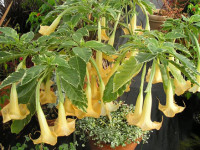All good designers know the value of making a bold statement. Whether your garden style tends toward the colorful and over-the-top, or a more subtle scheme that will benefit from the occasional exclamation point, tropical plants can work for you.
The line between “annuals” and “tropicals” is blurry, as many of the plants we grow as annuals are actually native to the tropic zones. That in fact is what makes many annuals bloom and bloom: the tropics know no seasons, so plants from there are adapted to grow and flower year round. But for gardeners here in Zone 5, “tropicals” usually refers to the tender bulbs, shrubs and trees that are grown for their large scale foliar effects, like Cannas, Elephant Ears, Bananas, Hibiscus, Gingers, Agaves, and the like.
Many gardeners would like to grow these plants but are daunted by the idea of carrying them over from one year to the next. But you don’t need a greenhouse or a conservatory to succeed with tropicals, just a little effort and ingenuity. Many of those with a bulb or rhizome will winter over easily in a cool basement corner after the tops have been cut down by the first frosts. Others will survive quite well in a sunny window, and still others can be forced into a resting period and held over as bare trunks in a dark, frost-free spot. The reward for your efforts will be a bigger and even more dramatic specimen for the next year, ready to shine as a star player in your garden scheme.

Part of the spectacular tropical border at the former Loomis Creek Nursery, designed by Andrew Beckman and Bob Hyland.

Princess Flower (Tibouchina), a shrub native to Brazil that offers velvety foliage and gorgeous jewel-toned flowers.
Whether you choose to carry them over or simply to replace them every season, these plants grow quickly and fill out beautifully as soon as the days and nights warm up. They’re ideal for lending height and bulk to a group of container plants, and for plunging into borders of hardy plants that could use a little extra drama.
We encourage you to try some of these exciting plants and learn the simple tricks of keeping them going to provide year after year of beauty and satisfaction. At Pondside, we sell more of these plants every season to gardeners who’ve discovered that for color, scale and impact, tropicals are a great value, and well worth the extra effort!



